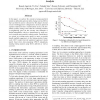Free Online Productivity Tools
i2Speak
i2Symbol
i2OCR
iTex2Img
iWeb2Print
iWeb2Shot
i2Type
iPdf2Split
iPdf2Merge
i2Bopomofo
i2Arabic
i2Style
i2Image
i2PDF
iLatex2Rtf
Sci2ools
VLSID
2002
IEEE
2002
IEEE
Efficient Generation of Delay Change Curves for Noise-Aware Static Timing Analysis
In this paper, we explore the concept of using analytical models to efficiently generate delay change curves (DCCs) that can then be used to characterize the impact of noise on any victim/aggressor configuration. Such an approach captures important noise considerations such as the possibility of delay change even when the switching windows of neighboring gates do not overlap. The technique is model-independent, which we demonstrate by using several crosstalk noise models to obtain results. Furthermore, we extend an existing noise model to more accurately handle multiple aggressors in the timing analysis framework. DCC results from the analytical approach closely match those from time-consuming SPICE simulations, making timing analysis using DCCs efficient as well as accurate.
Computer Architecture | Crosstalk Noise Models | Delay Change | Important Noise Considerations | VLSID 2002 |
Related Content
| Added | 01 Dec 2009 |
| Updated | 01 Dec 2009 |
| Type | Conference |
| Year | 2002 |
| Where | VLSID |
| Authors | Kanak Agarwal, Yu Cao, Takashi Sato, Dennis Sylvester, Chenming Hu |
Comments (0)

